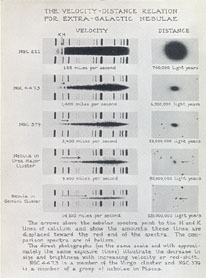


Possible Interpretations of Red-Shifts
When first observed the red-shifts were immediately attributed to radial motion away from the observer, to recession of the nebulae. This interpretation still remains the only permissible explanation that is known. It is true that other ways are known by which red-shifts might be produced, but in each case they would be accompanied by other phenomena which would be conspicuous and, actually, are not found. We may state with some confidence that red-shifts are the familiar velocity-shifts, or else they represent some unrecognized principle of nature. We cannot assume that our knowledge of physical principles is yet complete; nevertheless, we should not replace a known, familiar principle by an ad hoc explanation unless we are forced to that step by actual observations.
Most of the theoretical investigators adopt this point of view, and accept without question the interpretation of red-shifts as velocity-shifts. They are fully justified in their position until evidence to the contrary is forthcoming. But these lectures will present a remarkable situation. The familiar interpretation of red-shifts seems to imply a strange and dubious universe, very young and very small. On the other hand, the plausible and, in a sense, familiar conception of a universe extending indefinitely in space and time, a universe vastly greater than the observable region, seems to imply that red-shifts are not primarily velocity-shifts.
In view of this possible conflict, whether of facts or theories or speculations, the observer is inclined to keep an open mind and to adopt parallel working hypotheses for the interpretation of his explorations. He may assume, first, that red-shifts are velocity-shifts, or, secondly, that red-shifts result from some unknown principle that does not involve actual motion, and always, of course, he will search for some empirical, critical test for distinguishing between the two assumptions, between motion and no motion.
 |
PLATE V. RED-SHIFTS The arrows above the nebular spectra point to the H and K lines of calcium and show the amounts these lines are displaced toward the red end of the spectra. The comparison spectra are of helium. The direct photographs (on the same, scale and with approximately the same exposure times) illustrate the decrease in size and brightness with increasing velocity or red-shift. NGC 4473 is a member of the Virgo Cluster and NGC 379 is a member of a group of nebulae in Pisces. |
Now let us examine the two assumptions. The true nature of light is still uncertain. For many purposes it can be discussed in two quite different ways, both of which lead to the same conclusions. We may picture light as spreading out in waves, or as travelling in bullet-like parcels of energy called quanta. Waves have various wave-lengths; quanta carry different amounts of energy. Since the same phenomenon can be logically described by both concepts, there is evidently some underlying connexion between them. This connexion is expressed in the very fundamental relation between the energy-content of a quantum, and the equivalent wave-length,
 |
Because of this relation an increase in
 implies a
decrease in E, or, we may-say, a reduction of E implies
an increase in
implies a
decrease in E, or, we may-say, a reduction of E implies
an increase in  .
In either case we observe only the
increased wave-length, and we have no direct way of
determining which of the two effects is fundamental.
If the primary change is in the wave-length, then red-shifts are
probably velocity-shifts. But the primary
change might possibly be a loss of energy, which we
would observe as a red-shift. In the latter case the
law of red-shifts would be fully described by the simple
statement that light loses energy in proportion to the
distance it travels through space. Thus, on general
considerations, we recognize alternative possibilities.
Let us examine them more closely, beginning with velocity-shifts.
.
In either case we observe only the
increased wave-length, and we have no direct way of
determining which of the two effects is fundamental.
If the primary change is in the wave-length, then red-shifts are
probably velocity-shifts. But the primary
change might possibly be a loss of energy, which we
would observe as a red-shift. In the latter case the
law of red-shifts would be fully described by the simple
statement that light loses energy in proportion to the
distance it travels through space. Thus, on general
considerations, we recognize alternative possibilities.
Let us examine them more closely, beginning with velocity-shifts.